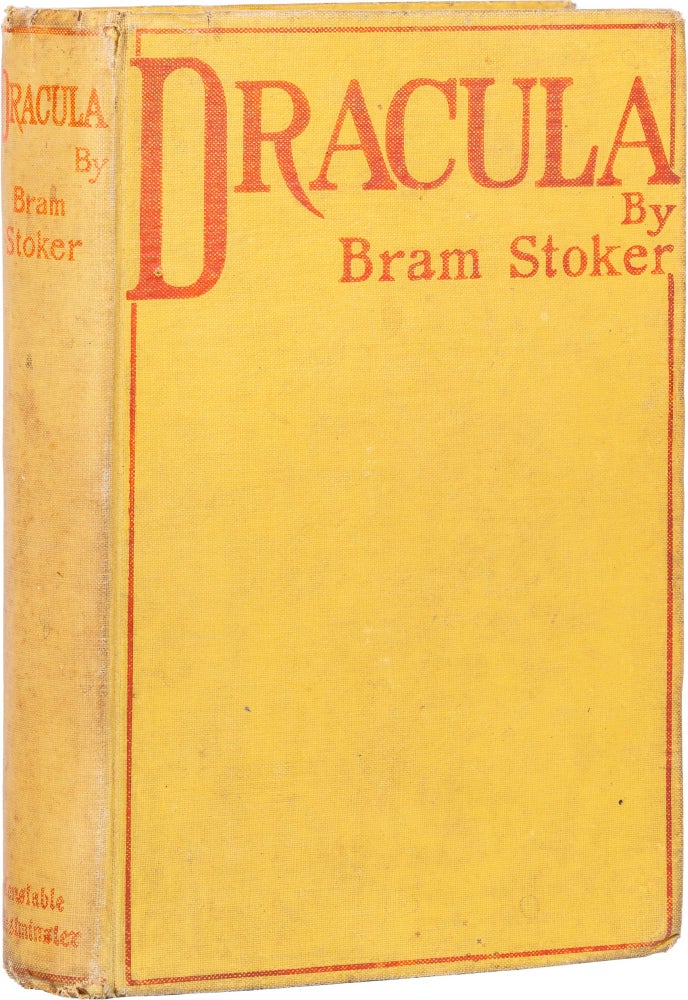Dracula
London: Constable, 1897. First Edition. Hardcover. 1st edition, 1st printing with no ad for The Shoulder of Shasta on the last integral leaf (2C4). 1st binding with no publisher’s catalog. Original cloth, soiled, wear to corners and tips, inner paper hinges undetectably strengthened, small pen mark to page 54, else very good. A bibliographically correct Dracula is much scarcer than widely assumed so if you want the real 1st edition (see below) and a sound copy of it, ours is for you. Very good. Item #494
In a reaction to the overthought and over explained, let’s hike the bibliographical path of fact (facts aren’t interested in your feelings) so as to carve a sturdy chronology for the 1st edition of Dracula, eliminating superfluous data, nefariously deceptive argot, and the dizzying abuse of terms, while remembering that few bookseller’s sales tactics are more sinful than knowing a book’s bibliography and lying about it for undeserved profit, and few disputes are more bitter than the quarrels between those who believe an idea today and those who will believe that idea tomorrow. 1. The 1st edition (1st impression): All 3,000 copies of the 1st printing have the last integral leaf blank, with no ad for The Shoulder of Shasta. Copies with the Shasta ad, even with no printed avowal that they are later impressions, are not later issues, or later bindings, or later states, they are all reprints (the 2nd, 3rd, and 4th printings), and in today’s candor they should not be called 1st editions (despite A. B. A. A.’s archaic glossary of terms), and when they are, it is a wicked duplicity, rationalized by now antiquated terminology, misused to mislead. And you should pay no more, percentagewise, for a Dracula with the Shasta ad than you would pay for any other book that stated “2nd impression” or “2nd printing” or “2nd edition” or had a number line ending in “2” or “3” or “4” (Book Code).
There were 2 bindings of the 1st printing, priority as below.
A. Bound without a publisher’s catalog. The rational argument for the priority of our state A is that all of Stoker’s presentation copies dated in late May and June, all of the earliest publisher’s presentation copies, a deposit copy, and all the early review copies, have no catalog (there may be an outlier but in my 45 years I’ve seen dozens of these markers). This evidence should be dispositive.
B. Bound with an undated publisher’s advertisement catalog listing no books published after 1897. The last book published that’s listed in this ad catalog is Warren’s editing of The Faerie Queene, its first 2 volumes published early in 1897 (Dalby’s bibliography missed it). The frail argument for the equality of state B is convoluted, with 4 “ifs”, but here it is. If all 3,000 copies of the 1st printing were bound before publication (there is no indication of this), and if the ad catalog was inserted into the first available copies until the supply was exhausted, and if the remaining copies of the 1st printings were bound without a catalog seeing as no subsequent catalog was yet available, then it could be fantasized, that if the publisher aimed to get the maximum number of copies with his ads into the hands of the retail buying public, he might have chosen, as a business strategy, to send author’s copies to Stoker, deposit copies to wherever, free copies to reviewers, and publisher’s copies to friends, without the catalog.
Reality: The analysis for 1–A stands beyond lucid argument. It’s the 1st binding. The analysis for 1–B, hinging on the publisher intentionally, exclusively, and successfully, selecting those copies with an ad catalog for retail sale only, is an illusory strategy that has not been demonstrated elsewhere in late Victorian publishing. Also, Dracula (published May 26) did not sell all that fast and it is almost certain that not all copies were initially bound, and the B binding was in fact bound later, adding the catalog. It’s the 2nd binding, and the 2nd issue.
2. The later editions: Copies of all the earliest re–printings carry an ad for The Shoulder of Shasta on the final integral leaf. The fact that the leaf is integral to the last signature is what separates this ad point from the usual ones as it is part of the text’s printing process and inseparable from the actual text, and it was printed with the text. This is much like additions to, or deletions from, the text in books of this vintage that often signify later printings. Clearly then, all copies with the Shasta ad are reprints, being the 2nd, 3rd, or 4th printing, and calling them “1st edition, 2nd state” or “1st edition, 2nd issue” is a charade, and if you own one, you have been duped. The 5th printing added “fifth impression” to the verso of the title page. Trying to divide and identify the 2nd, 3rd and 4th printings from one another is imprecise but the 2nd printing has the Shasta ad and most copies of it were bound with no inserted catalog of other ads following this leaf. The 3rd printing also carries the Shasta ad and most copies of it have an undated inserted catalog following this leaf listing some books published after Dracula’s May 26, 1897 publication date. The 4th printing still includes the Shasta ad and most copies of it have an inserted catalog dated 1898 following this leaf. And, as noted, copies of the 5th printing have the notation, “fifth impression.”
NOTE: Mixed states (bindings) occur but it is the blank integral last page with no Shasta ad, on which one should reliably lean as the definer of the 1st edition.
NOTE: At some point the supply of paper used on the earliest copies ran out and the new supply of paper was coated and thinner. Since no copies of the 1st printing were printed on thinner paper, and many copies of the 2nd printing were printed on thicker paper, it isn’t a factor, only a distracting confuser. Ignore it.
BEWARE: Reprints in original cloth are seen with the Shasta ad removed and replaced with a blank leaf of similar paper. Savvy buyers should examine this area with all the care exercised by porcupines during sex, and mistrust (avoid), for that reason, any rebound copy, unless it is an early dated presentation copy.
Price:
$50,000.00






